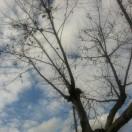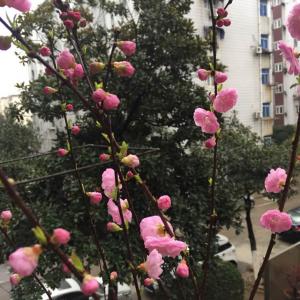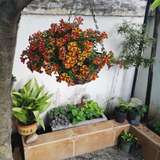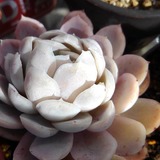求助
Lucky Coyote
2018年04月26日

two things:
1 what is the white pocking on the leaves? it happened after I had to repot it from being water-logged
2 is this ready or near ready to propagate babies, and how do I get them off and start them?
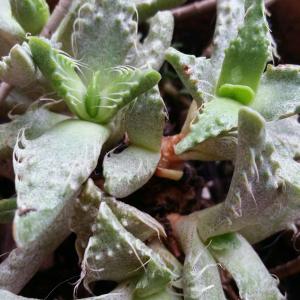
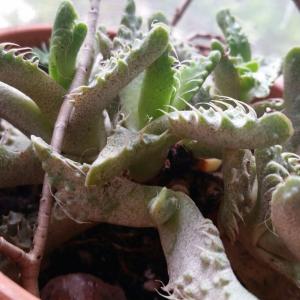
1 what is the white pocking on the leaves? it happened after I had to repot it from being water-logged
2 is this ready or near ready to propagate babies, and how do I get them off and start them?


0
0
文章
Miss Chen
2018年04月25日

Description: This perennial herbaceous plant consists of a low rosette of basal leaves up to 5" across, from which one or more flowering stalks develop. The blades of the basal leaves are up to 3½" and 2" across, although they are typically about one-half of this size during the blooming period. These leaf blades are ovate, oval, or cordate-oval in shape, while their margins are crenate. The upper surface of these leaf blades is medium green and glabrous to sparsely pubescent, while the lower surface is pale green and either glabrous, pubescent along the central vein, or pubescent generally. The petioles are less than one-third of the length of the leaf blades; they are light green to reddish green and glabrous to pubescent (hairs are especially likely to occur toward the bases of the petioles). The ascending pedicels of the flowers are 3-5" long, light green to reddish green, terete, and glabrous (less often pubescent). Toward the middle of each pedicel, there is a pair of tiny leafy bracts that are lanceolate in shape. The apices of the pedicels curve downward, where the flowers occur.
Each flower is about ½" across, consisting of 5 white spreading petals, 5 light green sepals, and the inconspicuous reproductive organs. The lowest petal of each flower has several purple veins and it is beardless (lacking a patch of hairs) at its base. Toward the back of the flower, this petal tapers into a short stout nectar-spur. The two lower lateral petals have either reduced purple veins or they are veinless; their bases are either beardless or slightly bearded. The upper lateral petals lack purple veins and they are always beardless. The sepals are lanceolate and glabrous; the basal lobes of the sepals are short and rounded. The blooming period of these flowers occurs from mid-spring to early summer, lasting about 3-4 weeks. In addition to the showy flowers that have been described, there are also inconspicuous cleistogamous flowers that are self-fertile; they are produced shortly afterwards. The fertilized showy flowers and cleistogamous flowers are replaced by green seed capsules that become up to ½" long at maturity; they are ovoid-oblongoid in shape and glabrous. At maturity, these capsules divide into 3 parts, flinging their seeds in the process. The small seeds are 1.0–1.5 mm. long and globoid to ovoid in shape. The root system consists of a slender crown with fibrous roots and stolon-like rhizomes; clonal offsets are produced from the rhizomes, causing small colonies of plants to develop.

Cultivation: The preference is partial sun, moist conditions, and sandy soil.
Range & Habitat: Primrose-leaved Violet occurs in only 3 counties of NE Illinois, where it is rare and native (see Distribution Map). It is state-listed as 'endangered.' Outside of Illinois, this violet occurs primarily in sandy areas along the Atlantic coastal plain and Gulf of Mexico region. There is also a variety of this violet that occurs in the Pacific northwest. Habitats include moist sand prairies, sandy shrub prairies, moist sandy savannas, openings in moist sandy woodlands, and sandy paths through wooded areas. Primrose-leaved Violet is found in high quality natural areas, especially where there have been wildfires that reduced overhead woody vegetation. It also adapts to grassy paths in these areas if they are not mowed too often or too low.

Faunal Associations: The flowers of Primrose-leaved Violet probably attract the same, or similar, insect pollinators as other violets with white flowers. Such insects include honeybees, bumblebees, long-horned bees (Synhalonia spp.), mason bees (Osmia spp.), an oligolectic Andrenid bee (Andrena violae), the Giant Bee Fly (Bombylius major), small- to medium-sized butterflies, and skippers (Robertson, 1929). Bees are the most important pollinators. Sometimes ants enter the flowers of violets to feed on nectar, but they are not effective pollinators. Other insects feed on the foliage and other parts of violets. These insect feeders include the caterpillars of several Fritillary butterflies (Boloria spp., Speyeria spp.), larvae of the Violet Sawfly (Ametastega pallipes), the Violet Aphid (Neotoxoptera violae), larvae of the Violet Fruit Midge (Dasineura semenivora) and Violet Gall Midge (Prodiplosis violicola), and a thrips (Odontothrips pictipennis); see Bouseman & Sternburg (2001), Smith (2006), Hottes & Frison (1931), Felt (1917), Aldrich & Osten-Sacken (1905), and Stannard (1968). The seeds of violets are eaten to some extent by such birds as the Ruffed Grouse, Wild Turkey, Bobwhite Quail, Mourning Dove, and Slate-colored Junco; the White-footed Mouse and Woodland Vole also eat the seeds. The Cottontail Rabbit and White-tailed Deer feed on the foliage of violets to a minor extent, as does the Eastern Chipmunk and Wood Turtle (Clemmys insculpta); see Martin et al. (1951/1961), Augustine (1997), Wrazen & Svendsen (1978), and Ernst et al. (1994).

Photographic Location: Grassy paths through moist sandy savannas and moist sandy woodlands at the Iroquois County Conservation Area in Illinois.
Comments: This is one of the smaller violets with dainty flowers and foliage. It remains inconspicuous, except when it blooms. Primrose-leaved Violet (Viola primulifolia) is probably a naturally occurring hybrid of two other native violets, Lance-leaved Violet (Viola lanceolata) and Small White Violet (Viola macloskeyi pallens). As a result, some authorities refer to Primrose-leaved Violet as a hybrid, or Viola × primulifolia. This violet can be distinguished from other violets (Viola spp.) by its white flowers and the shape of its leaves. These leaves are more broad than those of Lance-leaved Violet, but they are less orbicular in shape than those of Small White Violet. The Sand Violet (Viola fimbriatula) has leaves that are similar in shape to those of Primrose-leaved Violet, but the foliage of Sand Violet is usually more pubescent and its flowers are blue-violet. Across its range, the Primrose-leaved Violet is somewhat variable in the pubescence of its foliage. In the northern parts of its range (including Illinois), the foliage of this violet is mostly glabrous, but in the southern parts of its range (e.g., in SE United States), its foliage is more pubescent.
Each flower is about ½" across, consisting of 5 white spreading petals, 5 light green sepals, and the inconspicuous reproductive organs. The lowest petal of each flower has several purple veins and it is beardless (lacking a patch of hairs) at its base. Toward the back of the flower, this petal tapers into a short stout nectar-spur. The two lower lateral petals have either reduced purple veins or they are veinless; their bases are either beardless or slightly bearded. The upper lateral petals lack purple veins and they are always beardless. The sepals are lanceolate and glabrous; the basal lobes of the sepals are short and rounded. The blooming period of these flowers occurs from mid-spring to early summer, lasting about 3-4 weeks. In addition to the showy flowers that have been described, there are also inconspicuous cleistogamous flowers that are self-fertile; they are produced shortly afterwards. The fertilized showy flowers and cleistogamous flowers are replaced by green seed capsules that become up to ½" long at maturity; they are ovoid-oblongoid in shape and glabrous. At maturity, these capsules divide into 3 parts, flinging their seeds in the process. The small seeds are 1.0–1.5 mm. long and globoid to ovoid in shape. The root system consists of a slender crown with fibrous roots and stolon-like rhizomes; clonal offsets are produced from the rhizomes, causing small colonies of plants to develop.

Cultivation: The preference is partial sun, moist conditions, and sandy soil.
Range & Habitat: Primrose-leaved Violet occurs in only 3 counties of NE Illinois, where it is rare and native (see Distribution Map). It is state-listed as 'endangered.' Outside of Illinois, this violet occurs primarily in sandy areas along the Atlantic coastal plain and Gulf of Mexico region. There is also a variety of this violet that occurs in the Pacific northwest. Habitats include moist sand prairies, sandy shrub prairies, moist sandy savannas, openings in moist sandy woodlands, and sandy paths through wooded areas. Primrose-leaved Violet is found in high quality natural areas, especially where there have been wildfires that reduced overhead woody vegetation. It also adapts to grassy paths in these areas if they are not mowed too often or too low.

Faunal Associations: The flowers of Primrose-leaved Violet probably attract the same, or similar, insect pollinators as other violets with white flowers. Such insects include honeybees, bumblebees, long-horned bees (Synhalonia spp.), mason bees (Osmia spp.), an oligolectic Andrenid bee (Andrena violae), the Giant Bee Fly (Bombylius major), small- to medium-sized butterflies, and skippers (Robertson, 1929). Bees are the most important pollinators. Sometimes ants enter the flowers of violets to feed on nectar, but they are not effective pollinators. Other insects feed on the foliage and other parts of violets. These insect feeders include the caterpillars of several Fritillary butterflies (Boloria spp., Speyeria spp.), larvae of the Violet Sawfly (Ametastega pallipes), the Violet Aphid (Neotoxoptera violae), larvae of the Violet Fruit Midge (Dasineura semenivora) and Violet Gall Midge (Prodiplosis violicola), and a thrips (Odontothrips pictipennis); see Bouseman & Sternburg (2001), Smith (2006), Hottes & Frison (1931), Felt (1917), Aldrich & Osten-Sacken (1905), and Stannard (1968). The seeds of violets are eaten to some extent by such birds as the Ruffed Grouse, Wild Turkey, Bobwhite Quail, Mourning Dove, and Slate-colored Junco; the White-footed Mouse and Woodland Vole also eat the seeds. The Cottontail Rabbit and White-tailed Deer feed on the foliage of violets to a minor extent, as does the Eastern Chipmunk and Wood Turtle (Clemmys insculpta); see Martin et al. (1951/1961), Augustine (1997), Wrazen & Svendsen (1978), and Ernst et al. (1994).

Photographic Location: Grassy paths through moist sandy savannas and moist sandy woodlands at the Iroquois County Conservation Area in Illinois.
Comments: This is one of the smaller violets with dainty flowers and foliage. It remains inconspicuous, except when it blooms. Primrose-leaved Violet (Viola primulifolia) is probably a naturally occurring hybrid of two other native violets, Lance-leaved Violet (Viola lanceolata) and Small White Violet (Viola macloskeyi pallens). As a result, some authorities refer to Primrose-leaved Violet as a hybrid, or Viola × primulifolia. This violet can be distinguished from other violets (Viola spp.) by its white flowers and the shape of its leaves. These leaves are more broad than those of Lance-leaved Violet, but they are less orbicular in shape than those of Small White Violet. The Sand Violet (Viola fimbriatula) has leaves that are similar in shape to those of Primrose-leaved Violet, but the foliage of Sand Violet is usually more pubescent and its flowers are blue-violet. Across its range, the Primrose-leaved Violet is somewhat variable in the pubescence of its foliage. In the northern parts of its range (including Illinois), the foliage of this violet is mostly glabrous, but in the southern parts of its range (e.g., in SE United States), its foliage is more pubescent.
1
0
文章
Miss Chen
2018年04月25日

Description: This perennial plant consists of a rosette of basal leaves about 5" across. The blade of each basal leaf is about 2" long and ¾" across; it is oval to ovate-oblong, crenate and ciliate along the margins, and more or less hairy, especially along the lower surface. The bottom of each leaf blade has tiny basal lobes that are rounded or bluntly pointed, while the tip of the leaf blade is rather blunt and obtuse. The leaf blade may fold upward along its central vein. The stout petiole of each leaf is green to reddish brown and hairy; it is as long as the leaf blade or a little shorter. From the center of the rosette, there develops one or stalks of flowers up to 6" long. These stalks develop directly from the rootstock; they are reddish purple and either glabrous or hairy. Each of these stalks is naked, except for a pair of tiny leaf-like bracts near the middle. At the apex of each stalk, there is a single flower about ¾" across. It consists of 5 green sepals and 5 blue-violet petals consisting of 2 upper lateral petals, 2 lower lateral petals, and a bottom petal. The sepals are lanceolate and glabrous or hairy. The lower lateral petals have conspicuous white hairs near the throat of the flower. The bottom petal is white at the base and it has dark blue-violet lines that function as nectar guides for visiting insects.
The blooming period occurs from mid- to late spring and lasts about a month. There is no noticeable floral scent. Flowers that are successfully cross-pollinated will develop ovoid-oblongoid capsules that contain many seeds. Later, self-fertile cleistogamous flowers will develop from erect or ascending stalks; they lack petals and are inconspicuous. The cleistogamous flowers also produce seed capsules. These capsules divide into 3 parts at maturity, flinging the seeds. The seeds are small, globoid, and brown. The root system consists of stout scaly rhizomes with fibrous roots.
Cultivation: The preference is full sun to light shade, moist to slightly dry conditions, and sandy soil.

Range & Habitat: The native Sand Violet is occasional in sandy areas of central and northern Illinois, otherwise it is rare or absent (see Distribution Map). Habitats include sandy woodlands, thinly wooded slopes, sandy savannas, sand prairies, semi-shaded areas along sandy paths, and abandoned sandy fields. Usually, this species is found in mesic to slightly dry areas of these habitats. It benefits from occasional wildfires, as this reduces the competition from taller vegetation.
Faunal Associations: The flowers of violets (Viola spp.) are pollinated by bees, especially mason (Osmia spp.) and Andrenid bees. Butterflies and skippers may suck nectar from the flowers, but they are less effective at cross-pollination. The foliage of violets is eaten by the caterpillars of Fritillary butterflies and several species of moths (see Butterfly & Moth Table). The seeds are eaten to a limited extent by upland gamebirds, including the Mourning Dove, Ruffed Grouse, Bobwhite, and Wild Turkey. The Wild Turkey also digs up and eats the rhizomes. The White-Footed Mouse also eats the seeds of violets, while the White-Tailed Deer and Cottontail Rabbit browse on the foliage only very sparingly. Because the seeds have oily elaisomes (food appendages), they are distributed to some extent by ants and possibly other insects.

Photographic Location: Along a path through a sandy savanna that had been subjected to a recent wildfire in Kankakee County, Illinois.
Comments: The Sand Violet (Viola fimbriatula) is closely related to Viola sagitatta (Arrow-leaved Violet), and it is classified as a variety of the latter species, Viola sagitatta ovata, by some authorities. The Sand Violet is usually hairier and its basal leaves are more broad with blunt tips. The Arrow-leaved Violet has basal leaves that are more lanceolate with spreading basal lobes (i.e., they are hastate in shape). The Arrow-leaved Violet occurs throughout Illinois in both sandy and non-sandy habitats. Another species, Viola primulifolia (Primrose-leaved Violet), has basal leaves that are similar in shape to those of the Sand Violet, but its flowers are white. Sometimes this latter species is regarded as a hybrid.
The blooming period occurs from mid- to late spring and lasts about a month. There is no noticeable floral scent. Flowers that are successfully cross-pollinated will develop ovoid-oblongoid capsules that contain many seeds. Later, self-fertile cleistogamous flowers will develop from erect or ascending stalks; they lack petals and are inconspicuous. The cleistogamous flowers also produce seed capsules. These capsules divide into 3 parts at maturity, flinging the seeds. The seeds are small, globoid, and brown. The root system consists of stout scaly rhizomes with fibrous roots.
Cultivation: The preference is full sun to light shade, moist to slightly dry conditions, and sandy soil.

Range & Habitat: The native Sand Violet is occasional in sandy areas of central and northern Illinois, otherwise it is rare or absent (see Distribution Map). Habitats include sandy woodlands, thinly wooded slopes, sandy savannas, sand prairies, semi-shaded areas along sandy paths, and abandoned sandy fields. Usually, this species is found in mesic to slightly dry areas of these habitats. It benefits from occasional wildfires, as this reduces the competition from taller vegetation.
Faunal Associations: The flowers of violets (Viola spp.) are pollinated by bees, especially mason (Osmia spp.) and Andrenid bees. Butterflies and skippers may suck nectar from the flowers, but they are less effective at cross-pollination. The foliage of violets is eaten by the caterpillars of Fritillary butterflies and several species of moths (see Butterfly & Moth Table). The seeds are eaten to a limited extent by upland gamebirds, including the Mourning Dove, Ruffed Grouse, Bobwhite, and Wild Turkey. The Wild Turkey also digs up and eats the rhizomes. The White-Footed Mouse also eats the seeds of violets, while the White-Tailed Deer and Cottontail Rabbit browse on the foliage only very sparingly. Because the seeds have oily elaisomes (food appendages), they are distributed to some extent by ants and possibly other insects.

Photographic Location: Along a path through a sandy savanna that had been subjected to a recent wildfire in Kankakee County, Illinois.
Comments: The Sand Violet (Viola fimbriatula) is closely related to Viola sagitatta (Arrow-leaved Violet), and it is classified as a variety of the latter species, Viola sagitatta ovata, by some authorities. The Sand Violet is usually hairier and its basal leaves are more broad with blunt tips. The Arrow-leaved Violet has basal leaves that are more lanceolate with spreading basal lobes (i.e., they are hastate in shape). The Arrow-leaved Violet occurs throughout Illinois in both sandy and non-sandy habitats. Another species, Viola primulifolia (Primrose-leaved Violet), has basal leaves that are similar in shape to those of the Sand Violet, but its flowers are white. Sometimes this latter species is regarded as a hybrid.
0
0
文章
权问薇
2018年04月24日

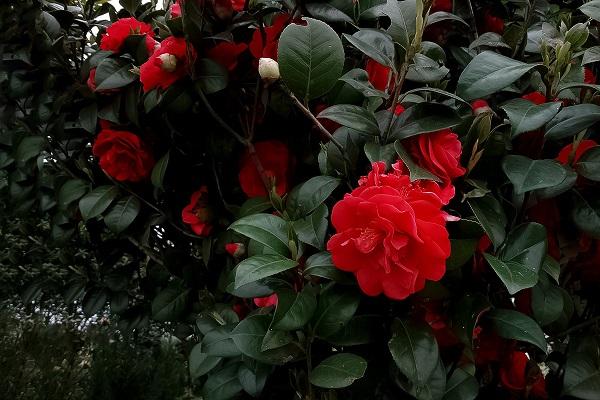
1、它对肥的需求量
相对来说,它对肥料的需量挺大。在不同的季节,它都有需求。不过,种类不同。接下来,就根据季节加以介绍。
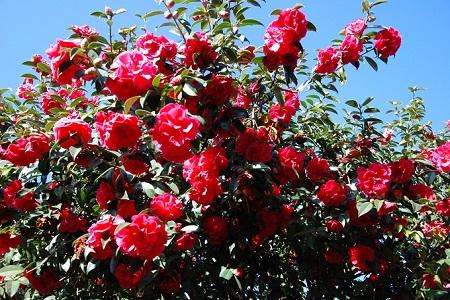
2、不同时期的种类
(1)首先说说基肥。在刚刚栽种下去,或者定期进行换盆换土的时候,可以加入适量腐熟的基肥,比如动物的粪便之类,这样有利于植株之后的成长,也会省去我们很多麻烦。
(2)再就是具体的施肥。在春季,主要是以N这种元素为主。具体的种类有人或者动物的粪便,或者其他的复合肥。这样,可以促进植株萌发出新的枝芽。至于频率,则控制在四到六天一次就好。

(3)在夏季,具体在五月份到六月份,这时大概就在花芽儿开始分化的时段了。那么,追加以P元素为主的肥是比较比较有利的,可以满足孕育花蕾的需要。比如,可以在已经沤制完成的肥中掺入一些过磷酸钙等,再加水浇根。
(4)在秋季,属于养分积累的阶段。考虑到要促进它安全过冬,那么可以用以P、K为主的肥,可提高抗冻的能力。
(5)在冬天,这种植物会进入半休眠的时段。这个时候,需要的肥量不是很多。要是使用,浓度也需要严格控制。具体来讲,可以使用一些含P、K的液态肥。
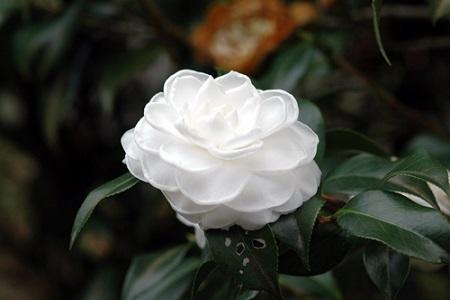
0
1
文章
权问薇
2018年04月24日


1、土壤
栀子花喜欢酸性环境,所以土壤一定要呈酸性,忌碱性。栽培的壤土可以选用腐叶土、菜园土、腐熟土、河沙以4:4:1:1的比例混合的土壤,但一定要保证其透气性和渗水性良好。

2、温度
它最佳的生长发育温度是在20至25℃之间,能忍受-3℃的低温,但不可久置,不然会造成冻伤。当温度高于15℃时要及时开窗通风,舒缓燥热,以利于其之后的生长、开花。
3、光照
它的生长环境一般光照非常充足,特别是春秋两季,每天都要保证它能接受至少8小时的日照,否则对其以后的越冬和生长都极为不利。但在阳光炽热的夏季,要避免强光曝晒,最好将其放在散光的地方养护,入冬之后再转移到阳光直射处养殖。

4、施肥
它并不喜肥,但也需要定期补充肥料,在施加肥料的前一天要停止浇水,大约十天一次施加腐熟的肥料即可,施过肥后再浇一次透水,九月份中旬基本就停止施肥了。
5、浇水
春秋比较干燥,做到每三天浇一次水即可,而夏天要在温度降下来后浇水,大约是下午两点。冬季要控制浇水,等盆土干燥时再浇水。

1
3
文章
八公
2018年04月24日


1、害虫简介
它主要危害枝条和叶子,可使叶子变黄、变枯。还会引发其他病害,使植株孱弱。在四月份之后,它比较多发。

2、人工方法
这是相对与虫子很少的情况来说的。在这种情况之下,就不需要用药物了。具体说,可以用刷子将虫子都刷掉。然后,将长过虫子的枝条都剪掉,病叶也处理掉。不要将它们乱扔,集中起来处理好。不过,要是数量实在太多,那就只能通过药物了。
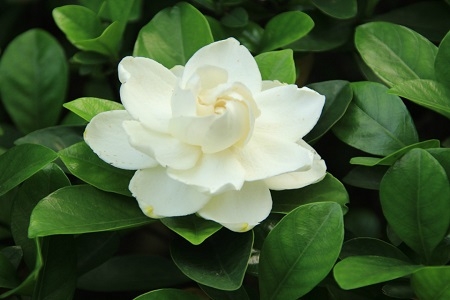
3、药物方法
(1)白酒:将白酒兑上水,比例大概在一比二。然后,浇到土的表面,将其浇透。每隔两个星期左右一次,连续四次就可以。
(2)食醋:取大概五十毫升的醋,将棉球浸入进去,用之在长虫的枝条、叶子上擦拭。这样,就可以将虫子消灭掉。这样做,既可以有效灭掉虫子,也可使植株的叶子显得更加有光泽,并且不会产生任何危害。所以,我们比较推荐这种方法。
(3)酒精:跟上一种方法一样,也是用它来擦拭植株。这种也比较彻底,并且还可以除掉一些我们用眼睛看不到的害虫、病菌。
(4)混合:将柴油、洗衣粉和水混合,按十比零点六比零点六比。然后,再用水稀释一下,就可以喷洒了。一周之后,虫子就会变得干瘪、死亡。

0
4
文章
Miss Chen
2018年04月24日

Description: This small deciduous shrub is ½-2' tall with spreading leafy branches. The trunk and branches of older shrubs are often woody with shredded bark, while young shoots and twigs are green to brownish red, terete, and finely warty. Sometimes the twigs and shoots are slightly short-pubescent. Alternate leaves along the twigs and shoots are ¾-1½" long and about ¼-¾" across; they are elliptic in shape and very finely serrated along their margins. Both the upper and lower surfaces of the leaves are medium to dark green and glabrous (or nearly so). The short petioles are up to 1/8" (3 mm.) in length.

Small clusters of nodding flowers develop from the preceding year's twigs. Each flower is about ¼" long and a little less across, consisting of a short green calyx with 5 teeth, a short-tubular corolla that is white or pinkish white, 10 inserted stamens, and an inferior ovary with a single style. The corolla is slightly indented along its upper rim, where 5 tiny lobes occur that are recurved. The peduncle and pedicels of the clustered flowers are light green to reddish brown and glabrous. The blooming period occurs from late spring to early summer for about 3 weeks. Afterwards, fertile flowers are replaced by globoid berries up to 1/3" (8 mm.) across that become dark blue with a whitish bloom at maturity. At this time, the fleshy interior of each berry is juicy and sweet and it typically contains 10-15 tiny seeds. The root system is usually shallow and spreading, although a taproot may develop on an older shrub. Vegetative colonies are produced from underground runners. The deciduous leaves often become red or burgundy during the the autumn.
Cultivation: The preference is full sun to light shade, mesic to dry conditions, and an acidic soil that is sandy. Cross-pollination between genetically distinct shrubs increases the production of fruit. This shrub may fail to produce flowers and fruit in areas that are too shady.
Close-up of TwigRange & Habitat: The native Lowbush Blueberry is occasional in NE Illinois (see Distribution Map). Habitats include sand prairies, shrub prairies, sandy savannas, sandy woodlands, rocky upland woodlands, rocky bluffs, sand dunes along Lake Michigan, and bogs. Lowbush Blueberry is sometimes the dominant understory shrub in some of these habitats, especially when they are sandy. This shrub becomes more abundant in response to occasional wildfires and the openings that such wildfires create.
Faunal Associations: The flowers are cross-pollinated primarily by various bees, including Andrenid bees (Andrena spp.), bumblebees, and honeybees. Both nectar and pollen are available as floral rewards. The pollen is released from the anthers in response to the "buzz pollination" of the bees (high frequency vibration of the thoracic muscles). In addition to these floral visitors, many insects feed on the foliage, stems, and other parts of blueberry shrubs. For example, the larvae of two beetles, Oberea myops (Rhododendron Stem Borer) and Oberea tripunctata (Dogwood Twig Borer), bore through the twigs of these shrubs, while the larvae of two flies, Dasineura cyanococci and Dasineura oxycoccum (Blueberry Gall Midge), form galls on the buds or developing flowers. Other insect feeders include the leaf beetles Altica sylvia and Tricholochmea vaccinii, the larvae of Rhagoletis mendax (Blueberry Fruit Fly), Clastoptera saintcyri (Heath Spittlebug), Limotettix vaccinii (Blunt-Nosed Leafhopper), and Mesolecanium nigrofasciatum (Terrapin Scale). The caterpillars of two butterflies, Callophrys augustinus (Brown Elfin) and Callophrys henrici (Henry's Elfin), feed on the flowers and developing fruits of blueberry shrubs. In addition to these insects, the caterpillars of such moths as Hemaris gracilis (Slender Clearwing), Sympistis dentata (Blueberry Cinder), and Xestia dilucida (Reddish Heath Dart) also feed on these shrubs (see the Moth Table for a more complete listing of these species). Blueberries fruits are an important source of food to many vertebrate animals. These species include the terrestrial turtles, Clemmys insculpta (Wood Turtle) and Terrapene carolina (Eastern Box Turtle); such birds as the Ruffed Grouse, Wild Turkey, Blue Jay, American Robin, Yellow-Breasted Chat, Wood Thrush, and Eastern Bluebird (see the Bird Table for a more complete listing of species); and such mammals as the Black Bear, Red Fox, Raccoon, Striped Skunk, Opossum, Red Squirrel, Eastern Chipmunk, Jumping Mouse, Deer Mouse, and White-Footed Mouse. In addition to the fruits, the White-Tailed Deer and Cottontail Rabbit also browse on the foliage and twigs. Because Lowbush Blueberry is a densely branched shrub that often forms large colonies, it provides significant protective cover for ground-nesting birds and other wildlife.

Comments: Lowbush Blueberry (Vaccinium angustifolium) is one of the primary sources of commercial blueberries, particularly in the New England region of the United States. The flavor of the berries is sweet and mild. Because this shrub is somewhat variable across its range, different varieties have been described, although none of these are currently recognized in Illinois. Compared to the Hillside Blueberry (Vaccinium pallidum), Lowbush Blueberry has more narrow leaves and its leaf undersides are less pale. It differs from another species, Canada Blueberry (Vaccinium myrtilloides), by having leaf undersides that are glabrous, rather than pubescent. These species usually occupy drier habitats than the taller Highbush Blueberry (Vaccinium corymbosum); the latter is typically found in forested bogs and similar wet habitats.

Small clusters of nodding flowers develop from the preceding year's twigs. Each flower is about ¼" long and a little less across, consisting of a short green calyx with 5 teeth, a short-tubular corolla that is white or pinkish white, 10 inserted stamens, and an inferior ovary with a single style. The corolla is slightly indented along its upper rim, where 5 tiny lobes occur that are recurved. The peduncle and pedicels of the clustered flowers are light green to reddish brown and glabrous. The blooming period occurs from late spring to early summer for about 3 weeks. Afterwards, fertile flowers are replaced by globoid berries up to 1/3" (8 mm.) across that become dark blue with a whitish bloom at maturity. At this time, the fleshy interior of each berry is juicy and sweet and it typically contains 10-15 tiny seeds. The root system is usually shallow and spreading, although a taproot may develop on an older shrub. Vegetative colonies are produced from underground runners. The deciduous leaves often become red or burgundy during the the autumn.
Cultivation: The preference is full sun to light shade, mesic to dry conditions, and an acidic soil that is sandy. Cross-pollination between genetically distinct shrubs increases the production of fruit. This shrub may fail to produce flowers and fruit in areas that are too shady.
Close-up of TwigRange & Habitat: The native Lowbush Blueberry is occasional in NE Illinois (see Distribution Map). Habitats include sand prairies, shrub prairies, sandy savannas, sandy woodlands, rocky upland woodlands, rocky bluffs, sand dunes along Lake Michigan, and bogs. Lowbush Blueberry is sometimes the dominant understory shrub in some of these habitats, especially when they are sandy. This shrub becomes more abundant in response to occasional wildfires and the openings that such wildfires create.
Faunal Associations: The flowers are cross-pollinated primarily by various bees, including Andrenid bees (Andrena spp.), bumblebees, and honeybees. Both nectar and pollen are available as floral rewards. The pollen is released from the anthers in response to the "buzz pollination" of the bees (high frequency vibration of the thoracic muscles). In addition to these floral visitors, many insects feed on the foliage, stems, and other parts of blueberry shrubs. For example, the larvae of two beetles, Oberea myops (Rhododendron Stem Borer) and Oberea tripunctata (Dogwood Twig Borer), bore through the twigs of these shrubs, while the larvae of two flies, Dasineura cyanococci and Dasineura oxycoccum (Blueberry Gall Midge), form galls on the buds or developing flowers. Other insect feeders include the leaf beetles Altica sylvia and Tricholochmea vaccinii, the larvae of Rhagoletis mendax (Blueberry Fruit Fly), Clastoptera saintcyri (Heath Spittlebug), Limotettix vaccinii (Blunt-Nosed Leafhopper), and Mesolecanium nigrofasciatum (Terrapin Scale). The caterpillars of two butterflies, Callophrys augustinus (Brown Elfin) and Callophrys henrici (Henry's Elfin), feed on the flowers and developing fruits of blueberry shrubs. In addition to these insects, the caterpillars of such moths as Hemaris gracilis (Slender Clearwing), Sympistis dentata (Blueberry Cinder), and Xestia dilucida (Reddish Heath Dart) also feed on these shrubs (see the Moth Table for a more complete listing of these species). Blueberries fruits are an important source of food to many vertebrate animals. These species include the terrestrial turtles, Clemmys insculpta (Wood Turtle) and Terrapene carolina (Eastern Box Turtle); such birds as the Ruffed Grouse, Wild Turkey, Blue Jay, American Robin, Yellow-Breasted Chat, Wood Thrush, and Eastern Bluebird (see the Bird Table for a more complete listing of species); and such mammals as the Black Bear, Red Fox, Raccoon, Striped Skunk, Opossum, Red Squirrel, Eastern Chipmunk, Jumping Mouse, Deer Mouse, and White-Footed Mouse. In addition to the fruits, the White-Tailed Deer and Cottontail Rabbit also browse on the foliage and twigs. Because Lowbush Blueberry is a densely branched shrub that often forms large colonies, it provides significant protective cover for ground-nesting birds and other wildlife.

Comments: Lowbush Blueberry (Vaccinium angustifolium) is one of the primary sources of commercial blueberries, particularly in the New England region of the United States. The flavor of the berries is sweet and mild. Because this shrub is somewhat variable across its range, different varieties have been described, although none of these are currently recognized in Illinois. Compared to the Hillside Blueberry (Vaccinium pallidum), Lowbush Blueberry has more narrow leaves and its leaf undersides are less pale. It differs from another species, Canada Blueberry (Vaccinium myrtilloides), by having leaf undersides that are glabrous, rather than pubescent. These species usually occupy drier habitats than the taller Highbush Blueberry (Vaccinium corymbosum); the latter is typically found in forested bogs and similar wet habitats.
0
0


